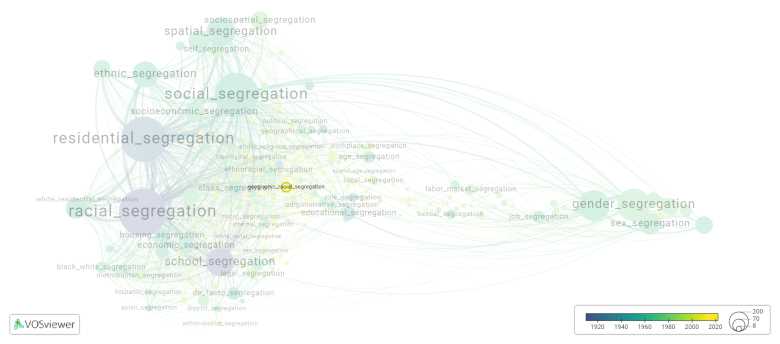Geographic racial segregation: Difference between revisions
(Creating page) |
(Creating page) |
||
| (6 intermediate revisions by the same user not shown) | |||
| Line 1: | Line 1: | ||
===== Date and country of first publication<ref>Date and country of first publication as informed by the Scopus database (December 2023).</ref>===== | |||
2019<br> | 2019<br> | ||
United States | |||
===== Definition ===== | |||
Geographic racial segregation refers to a pattern of spatial separation and concentration of different racial or ethnic groups within a specific area. It occurs when certain areas or neighborhoods are predominantly populated by one racial or ethnic group, leading to limited interaction and social contact between different racial groups. | Geographic racial segregation refers to a pattern of spatial separation and concentration of different racial or ethnic groups within a specific area. It occurs when certain areas or neighborhoods are predominantly populated by one racial or ethnic group, leading to limited interaction and social contact between different racial groups. | ||
| Line 12: | Line 12: | ||
Efforts to tackle geographic racial segregation often involve promoting fair housing policies, eliminating discriminatory practices in the housing market, and providing access to affordable housing across different neighborhoods and communities. Encouraging diverse and mixed-income neighborhoods can help promote integration, equal opportunities, and social cohesion. Additionally, fostering inclusive public spaces and supporting community initiatives that promote cross-cultural interactions can also play a role in addressing geographic racial segregation. | Efforts to tackle geographic racial segregation often involve promoting fair housing policies, eliminating discriminatory practices in the housing market, and providing access to affordable housing across different neighborhoods and communities. Encouraging diverse and mixed-income neighborhoods can help promote integration, equal opportunities, and social cohesion. Additionally, fostering inclusive public spaces and supporting community initiatives that promote cross-cultural interactions can also play a role in addressing geographic racial segregation. | ||
==See also== | ==See also== | ||
==Related segregation forms== | |||
Geographic racial segregation is frequently discussed in the literature with the following segregation forms: | |||
[[social segregation]], [[racial segregation]] | |||
[[File:geographic_racial_segregation.png|780x780px]] | |||
This visualization is based on the study [[Segregation_Wiki:About| The Multidisciplinary Landscape of Segregation Research]]. | |||
For the complete network of interrelated segregation forms, please refer to: | |||
* [https://tinyurl.com/2235lkhw First year of publication] | |||
* [https://tinyurl.com/2d8wg5n3 Louvain clusters] | |||
* [https://tinyurl.com/223udk5r Betweenness centrality] | |||
* [https://tinyurl.com/244d8unz Disciplines in which segregation forms first emerged (Scopus database).] | |||
==References== | ==References== | ||
==Notes== | ==Notes== | ||
<references /> | <references /> | ||
{{NoteAI}} | {{NoteAI}} | ||
== | ==Geographic racial segregation appears in the following literature== | ||
Austin A.M., Carmichael D.Q., Bynum J.P.W., Skinner J.S. (2019) Measuring racial segregation in health system networks using the dissimilarity index. ''Social Science and Medicine'', ''240''(), -. Elsevier Ltd. | Austin A.M., Carmichael D.Q., Bynum J.P.W., Skinner J.S. (2019). Measuring racial segregation in health system networks using the dissimilarity index. ''Social Science and Medicine'', ''240''(), -. Elsevier Ltd.https://doi.org/10.1016/j.socscimed.2019.112570 | ||
Latest revision as of 07:17, 16 October 2024
Date and country of first publication[1][edit | edit source]
2019
United States
Definition[edit | edit source]
Geographic racial segregation refers to a pattern of spatial separation and concentration of different racial or ethnic groups within a specific area. It occurs when certain areas or neighborhoods are predominantly populated by one racial or ethnic group, leading to limited interaction and social contact between different racial groups.
Geographic racial segregation can be a result of historical and systemic factors, including discriminatory housing policies such as redlining, restrictive covenants, and racially motivated zoning laws. These policies have often led to the exclusion of certain racial or ethnic groups from certain neighborhoods or communities, contributing to their concentrated presence in specific areas.
The consequences of geographic racial segregation can be far-reaching. It can exacerbate socioeconomic disparities, as neighborhoods with higher concentrations of racial minorities often have limited access to quality education, job opportunities, healthcare services, and other resources. Additionally, it can perpetuate racial stereotypes, prejudices, and tensions, as it limits interracial interaction and understanding.
Efforts to tackle geographic racial segregation often involve promoting fair housing policies, eliminating discriminatory practices in the housing market, and providing access to affordable housing across different neighborhoods and communities. Encouraging diverse and mixed-income neighborhoods can help promote integration, equal opportunities, and social cohesion. Additionally, fostering inclusive public spaces and supporting community initiatives that promote cross-cultural interactions can also play a role in addressing geographic racial segregation.
See also[edit | edit source]
Related segregation forms[edit | edit source]
Geographic racial segregation is frequently discussed in the literature with the following segregation forms:
social segregation, racial segregation

This visualization is based on the study The Multidisciplinary Landscape of Segregation Research.
For the complete network of interrelated segregation forms, please refer to:
References[edit | edit source]
Notes[edit | edit source]
- ↑ Date and country of first publication as informed by the Scopus database (December 2023).
At its current state, this definition has been generated by a Large Language Model (LLM) so far without review by an independent researcher or a member of the curating team of segregation experts that keep the Segregation Wiki online. While we strive for accuracy, we cannot guarantee its reliability, completeness and timeliness. Please use this content with caution and verify information as needed. Also, feel free to improve on the definition as you see fit, including the use of references and other informational resources. We value your input in enhancing the quality and accuracy of the definitions of segregation forms collectively offered in the Segregation Wiki ©.
Geographic racial segregation appears in the following literature[edit | edit source]
Austin A.M., Carmichael D.Q., Bynum J.P.W., Skinner J.S. (2019). Measuring racial segregation in health system networks using the dissimilarity index. Social Science and Medicine, 240(), -. Elsevier Ltd.https://doi.org/10.1016/j.socscimed.2019.112570
